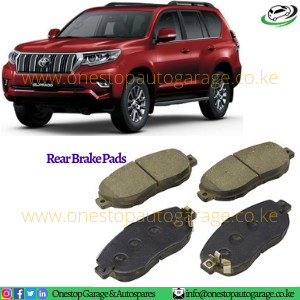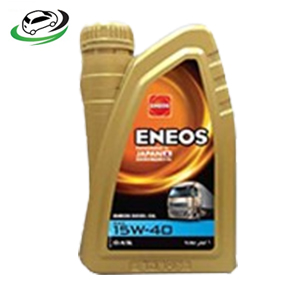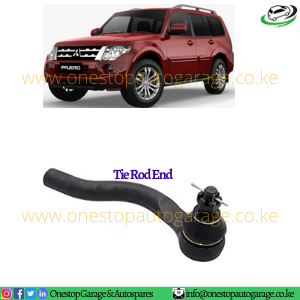-13%
Find the best prices for Tie Rod End Mitsubishi Pajero V73 V75 in Nairobi Kenya.
The Price for Mitsubishi Pajero Tie Rod End is @Ksh7000 each in Nairobi Kenya.
Tierod ends, also known as tie rod ends, are essential components in a vehicle’s steering system, connecting the steering linkage to the wheels. Playing a pivotal role in translating steering input into wheel movement, tierod ends contribute to the precision, responsiveness, and overall control of the vehicle. Understanding the importance of tierod ends and recognizing signs of wear is crucial for maintaining optimal steering performance and ensuring safety during driving.
Importance of Tierod Ends:
- Steering Linkage Connection: Tierod ends serve as the connection points between the steering linkage and the steering knuckle or wheel assembly. This linkage is responsible for transmitting the driver’s steering input to the wheels, determining the direction in which the vehicle moves. Properly functioning tierod ends are crucial for maintaining a direct and accurate connection between the steering system and the wheels.
- Alignment Adjustment: The adjustability of tierod ends plays a vital role in aligning the wheels properly. Precise wheel alignment is crucial for even tire wear, optimal handling, and preventing issues like vehicle pulling to one side. Proper alignment, facilitated by tierod ends, contributes to a stable and controlled driving experience.
- Steering Stability: Tierod ends contribute to the overall stability and balance of the vehicle during steering maneuvers. They help prevent excessive play or looseness in the steering system, ensuring that the wheels respond promptly to the driver’s input. Steering stability is essential for safe and predictable handling on the road.
- Cornering Performance: During cornering, tierod ends play a crucial role in maintaining consistent wheel alignment. This contributes to the stability of the vehicle, allowing for smooth and controlled turns. Well-maintained tierod ends enhance cornering performance and minimize the risk of skidding or loss of control.
- Tire Wear Prevention: Properly functioning tierod ends contribute to even tire wear. Misaligned wheels, often caused by worn-out tierod ends, can lead to uneven tire tread wear patterns. Regular wheel alignment adjustments, facilitated by tierod ends, help extend the lifespan of tires and ensure optimal traction.
- Responsive Steering: Tierod ends are integral to the responsiveness of the steering system. Worn-out or damaged tierod ends can result in delayed or imprecise steering responses. Maintaining the integrity of tierod ends ensures that the steering system reacts promptly to driver input, providing a smooth and controlled driving experience.
Signs of Worn-Out Tierod Ends:
- Excessive Play or Looseness: One of the primary signs of worn-out tierod ends is the presence of excessive play or looseness in the steering wheel. If drivers notice that the steering wheel moves excessively without corresponding wheel movement, it suggests that the tierod ends may be worn and require attention.
- Uneven Tire Wear: Worn tierod ends can lead to misalignment, resulting in uneven tire wear. Inspecting the tires for irregular wear patterns, such as excessive wear on one side or in specific areas, is indicative of a potential issue with the tierod ends. Addressing misalignment promptly is crucial to prevent further damage to the tires.
- Vibrations or Shimmying: Worn tierod ends can cause vibrations or shimmying sensations in the steering wheel, especially during acceleration or at certain speeds. These vibrations may be felt through the steering wheel and indicate that the tierod ends are not providing the necessary stability.
- Clunking or Knocking Noises: Audible clunking or knocking noises, particularly when turning or driving over bumps, are common signs of worn-out tierod ends. These sounds occur as the tierod ends lose their ability to absorb and dampen shocks, leading to increased play and movement in the steering components.
- Difficulty Steering or Drifting: If the vehicle exhibits difficulty steering or tends to drift to one side, it may be a sign of worn-out tierod ends. The inability to maintain a straight path or the need for constant steering corrections indicates a loss of steering control, necessitating a thorough examination of the tierod ends.
- Fluid Leaks: Some vehicles are equipped with rack-and-pinion steering systems that include power steering fluid. Leakage around the tierod ends may indicate damage or wear, compromising their effectiveness. Fluid leaks require immediate attention to prevent further deterioration of the tierod ends and the steering system.
- Visible Wear or Damage: A visual inspection of the tierod ends can reveal signs of wear or damage. Cracks, tears, or visible deterioration in the protective boots that cover the tierod ends indicate potential issues. Additionally, if there is any noticeable play or movement in the joints, it suggests worn-out tierod ends that require replacement.
- Difficulty Maintaining Wheel Alignment: Worn tierod ends can lead to difficulties in maintaining proper wheel alignment. If the vehicle consistently pulls to one side, even after alignment adjustments, it may indicate issues with the tierod ends. Persistent alignment problems should be addressed promptly to prevent further complications.
Conclusion:
Tierod ends are critical components in a vehicle’s steering system, influencing responsiveness, stability, and overall control. Recognizing the signs of worn-out tierod ends, such as excessive play, uneven tire wear, and steering difficulties, is essential for maintaining optimal steering performance and ensuring the safety of the vehicle and its occupants. Regular inspections, timely replacements, and adherence to recommended maintenance schedules contribute to the longevity and reliability of tierod ends, supporting a smooth and controlled driving experience. By understanding the importance of tierod ends and staying vigilant for signs of wear, vehicle owners can uphold the integrity of their steering systems and promote safe journeys on the road.



